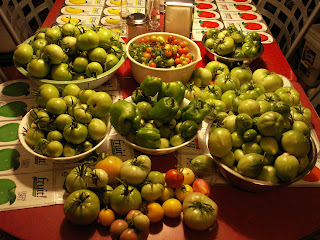
Last month I went to take a shower one Tuesday night and we lost water pressure in the house. I wasn't worried about it at the time because we mysteriously lose pressure from time to time.
We tried to get the water pressure back Wednesday morning in the usual way. Turn the switch until the pump comes on and wait for the pressure tank to fill. The switch came on, we heard the pump going, but after 5-10 minutes the tank still wasn't full. We went inside to research what might be causing the failure. We also got out the stored water jugs to satisfy our baseline water needs.
There are five main parts that could malfunction: the pressure tank, the pressure switch, the pump, the pump switch, and the pipes. We had recently replaced the pressure tank so ruled that out to start with. The pressure switch and pump both seemed to be working but we couldn't tell for sure. It seemed like the only choice was to pull the pump, inspect the pipes, and hope we found an obvious problem. By this time it was too late Wednesday to pull the pump. Day 1: no water.
Thursday morning we devised a plan and got ready to pull the pump. The pump was attached to a steel cable that goes over a pulley and connects to a hand or drill powered winch.
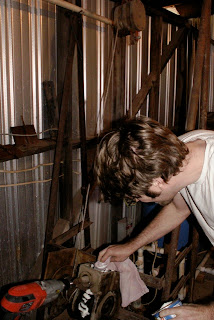
Husband greases the winch with some old crisco.

Looking down the well after we've raised the pump the first 6 feet.
Our choices for raising the pump were either to take the roof above the well off to let the steel pipe go through or cut the pipe every 6 feet once it reached the ceiling. We tried taking the roof apart but the last owners had glued huge sheets of shingles with tar up there so we went with cutting the pipe.
We cut the first length with our trusty generic sawzall (possibly the most destructive and useful tool we own). We didn't have to worry about the remaining pipe falling because it was connected to the pump, which was supported by the steel cable. So we kept at it. Pull the pipe up 6 feet, cut it, repeat.
The first few sections of pipe were relatively clean because they were above the water line.
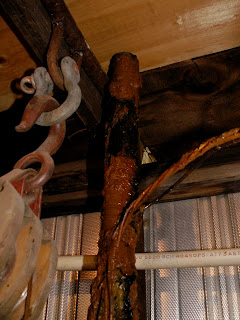
Pipe from below the water line.
The pipe from below the water line was shocking at first. This is the point where we started getting filthy. We kept raising and cutting the pipe hoping to find some kind of damage. Since we decided to cut the pipe as we raised the pump we planned on replacing it anyway so finding some damage would have been great. If the pipe was damaged that might mean we didn't have to replace the pump.

Yes! A hole in the pipe!
Finally, after we had pulled about 40 feet of pipe, we found a hole. If we're lucky, this might be the only thing keeping us from getting water pressure.
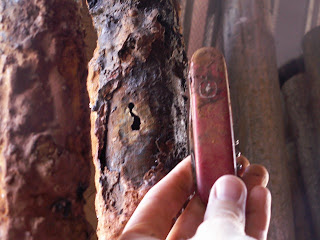
The hole compared to a Swiss army knife. I apologize for the grimy knife. My hands are still surprisingly clean at this point because my thick gloves have yet to be saturated with corrosion.
We still had a few more sections of pipe to cut at this point but we eventually made it down to the pump. We had to pull it all the way out to see what kind of connection to get when we replaced the pipe.
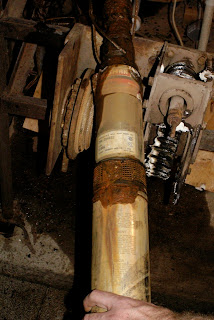
Our pump, a submersible Craftsman, looks pretty good. Yay!
We detached the pump, made our careful shopping list, and headed into town. The list: 100' 1" PEX pipe & clamps, PEX crimp tool ($40!) , PEX to PVC fittings, PVC backflow valve & disconnecting coupler. We went with PEX, a semi-flexible plastic pipe, so we wouldn't have to cut the pipe the next time we wanted to raise the pump. We also got a screw-type coupling for the PVC so we wouldn't have to cut it either. Both of these turned out to be good choices but more on that later.

The old pipe. About 60' total.
We hit the store and ran some other errands while we were in town. We made it back by about 10:00 p.m. Husband really wanted to try to get it all put back together that night so he could take a shower. I was not so keen but didn't want him to do it alone so off we went.
We attached the pump to the PEX, taped the wires to it as best we could and lowered it all back down. It didn't go down quite as smoothly as it came up because the PEX wouldn't unwind completely straight. The perpetual bend caused the pump to scrape the sides of the casing and hit the remaining old pipes as it went down. Husband did his best to keep it going in straight as I operated the winch.
We finally got it all connected and down about midnight. But to our dismay, when we hit the switch there was nothing. Complete silence. We gave up and went to bed. Day 2: no water.
Friday. We tried turning everything on again in case we had made some stupid mistake the night before. No good. We had no choice but to pull the pump again and see if we could figure out what the problem was.
We pulled the pump and looped the PEX around the shop as best we could. This is already a long story so I'll make this part short: we found some places were the wires were damaged and decided to replace the wires. We went back into town, bought what we needed, and came back that night. It was only about 8:00 p.m. but we were already tired and we had other work to do (the kind that pays) so we called it a night. Day 3: no water.
Saturday. Well, we thought, since we've gone to all this trouble why not pull out those other old pipes while we're at it? They might have contributed to our pump scraping as it was lowered and damaged the previous wiring.
The problem was, these pipes were from an old jet pump that was mounted on the surface. The only thing holding them up was the plate they rested on at the top of the well. We couldn't just lift and cut them like the other pipe.
Here's where I devised an ingenious solution. The plan was: we pull the pipes, attach them to the pulley above, drill holes in the pipes, lace steel cable through the holes, attach the steel cable to the pulley above, then cut the pipes above the cable.
This plan mostly worked. I almost ruined it by trying to change the plan mid-execution but luckily we found some extra chains, straps, and hooks around the shop and in the truck and we able to salvage it.
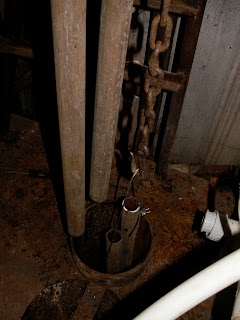
Removing the second set of old pipes.
This was the only part of the entire adventure that got a little scary. If we dropped the remaining pipes down the well that would be near disaster. Every time we moved something we put a backup on it in case it fell while we were moving it. The cable, chain, hook, pulley management was chaotic.

The tangle. The green strap is holding the pipes that were just cut. The chain is connected to the steel cable holding the pipes that are still hanging in the well. The backup on the lower pipes isn't in place yet.
At this point, we took a break to help our neighbor find his dog. Charlie the chihuahua had chased a cat into the forest. We tromped around the forest for a half an hour and returned to find that Charlie had found his way back home. That was probably a good break to blow off some steam. Now back to work.
Taking these pipes out was difficult because they were connected at the bottom. They appeared to be flexible beyond a certain point but we couldn't tell for sure. We did the drill, hang, cut, lift routine a few more times and got the flexible part within a foot or two of the well opening.
Then Husband came up with a new ingenious plan: attach the pipes to truck and pull them out the rest of the way. We set up an elaborate strap system. The come-along winch was holding the pipes up and was attached to a post in the shop. We attached the pipes to a strap, to a chain, to the truck.
I got in and drove as slowly as I could while Husband shouted from the shop. It worked! The rest of the pipes came out rather easily.
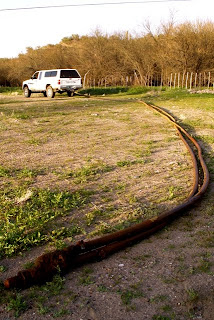
About 40' of pipe from the old jet pump.
With the old pipes removed, we were ready to rewire, test, and lower the pump again.

Empty well casing.
We rewired the pump and decided we'd better test it at ground level. We didn't want to use much water because we had a limited number of water jugs so we lined a half steel barrel with a tarp and partially filled it with water. We submerged the pump and hit the switch.

The pump test.
And it worked! The pump fired up and we danced and celebrated (sorry no pictures of this, we were really seriously dirty at this point).
We lowered the pump once more.
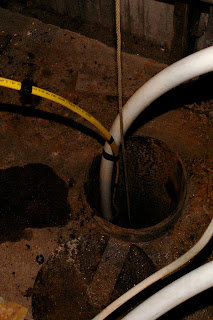
Day 4: running water and hot showers restored!
And we lived happily ever.


